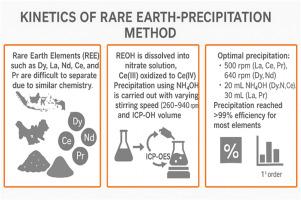Chemical kinetics of Rare Earth Element (REE) separation by precipitation method
IF 3.4
4区 化学
Q2 CHEMISTRY, MULTIDISCIPLINARY
引用次数: 0
Abstract
CHEMICAL KINETICS OF RARE EARTH ELEMENT (REE) SEPARATION BY PRECIPITATION METHOD. REE, are difficult to separate due to their similar properties yet are highly useful especially in advanced material industries. REE purification process uses precipitation is conducted to remove unwanted major elements in the material. This study aims to determine the optimum stirring speed and volume of NH3(aq) addition, and analyze the order and reaction speed constants in the separation of REE using the precipitation method. The materials used were REOH from monazite sand processing with observed elements is limited to Dy, La, Nd, Ce, and Pr. The precipitation variations used include stirring speed (260–940 rpm) and the addition of NH3(aq) volume (10–30 mL). The results showed that the optimum condition of stirring speed for La, Ce, and Pr elements was 500 rpm with efficiency values of 79.51 %, 99.76 %, and 98.89 %, while Dy and Nd elements were 640 rpm with efficiency values of 99.97 % and 99.15 %. The optimum NH3(aq) volume addition condition is 20 mL for Dy, Nd, and Ce elements with efficiency values touching 99.99 % on all three elements, while La and Pr elements at a volume of 30 mL with efficiency values of 99.95 % and 99.97 %. The reaction takes place in the first order reaction in all variations. The effect of stirring speed on reaction constants showed that Dy and La had the highest constants at 640 rpm with values of −4.1x10−6 min−1 and -7.26x10- 4min−1 respectively, Nd at 500 rpm with −7.24x10−5min−1, and Ce and Pr at 260 rpm with 1.73x10−4 and −2.1x10−5. The effect of NH3(aq) volume addition on the reaction constants showed that Dy had the highest constant at 20 mL with 1.27x10−6min−1, La at 30 mL with −2.07x10−5min−1, and Nd, Pr, and Ce at 25 mL with −1.59x10−6min−1, 3.12x10−6min−1, and 2.37x10−6min−1, respectively.

沉淀法分离稀土元素的化学动力学研究
沉淀法分离稀土元素的化学动力学。稀土元素,由于其相似的性质而难以分离,但在先进材料工业中具有很高的用途。稀土净化工艺采用沉淀法去除物料中不需要的主要元素。本研究旨在确定NH3(aq)的最佳搅拌速度和加入量,并分析沉淀法分离稀土的顺序和反应速度常数。所使用的材料是从单氮石制砂过程中得到的REOH,观察到的元素仅限于Dy, La, Nd, Ce和Pr。所使用的沉淀变化包括搅拌速度(260-940 rpm)和NH3(aq)的添加量(10-30 mL)。结果表明:La、Ce和Pr元素的最佳搅拌转速为500 rpm,效率分别为79.51%、99.76%和98.89%;Dy和Nd元素的最佳搅拌转速为640 rpm,效率分别为99.97%和99.15%。对Dy、Nd、Ce元素的最佳NH3(aq)添加量为20 mL,对3种元素的效率均达到99.99%;对La、Pr元素的最佳NH3(aq)添加量为30 mL,对3种元素的效率分别达到99.95%和99.97%。反应在所有变化中都以一级反应进行。搅拌速度对反应常数的影响表明,Dy和La在640 rpm时的反应常数最高,分别为- 4.1x10 - 6 min - 1和-7.26x10- 4min - 1, Nd在500 rpm时的反应常数为- 7.24x10 - 5min - 1, Ce和Pr在260 rpm时的反应常数为1.73x10 - 4和- 2.1x10 - 5。NH3(aq)体积加入对反应常数的影响表明,Dy在20 mL时的反应常数最高,为1.27x10 - 6min - 1, La在30 mL时为- 2.07x10 - 5min - 1, Nd、Pr和Ce在25 mL时分别为- 1.59x10 - 6min - 1、3.12x10 - 6min - 1和2.37x10 - 6min - 1。
本文章由计算机程序翻译,如有差异,请以英文原文为准。
求助全文
约1分钟内获得全文
求助全文
来源期刊
CiteScore
3.50
自引率
7.70%
发文量
492
审稿时长
3-8 weeks
期刊介绍:
The Journal of the Indian Chemical Society publishes original, fundamental, theorical, experimental research work of highest quality in all areas of chemistry, biochemistry, medicinal chemistry, electrochemistry, agrochemistry, chemical engineering and technology, food chemistry, environmental chemistry, etc.

 求助内容:
求助内容: 应助结果提醒方式:
应助结果提醒方式:


